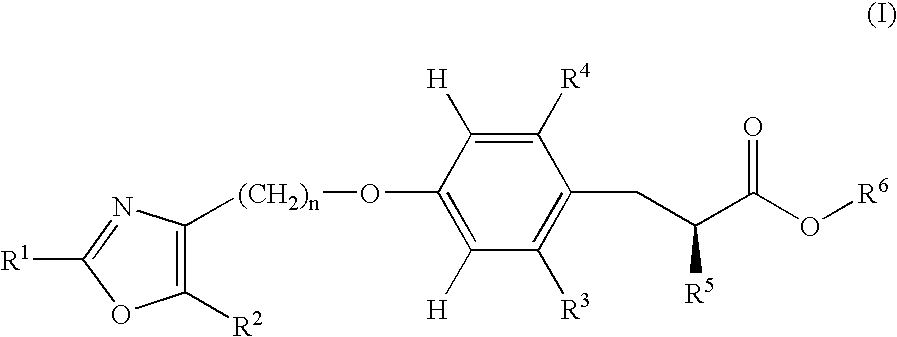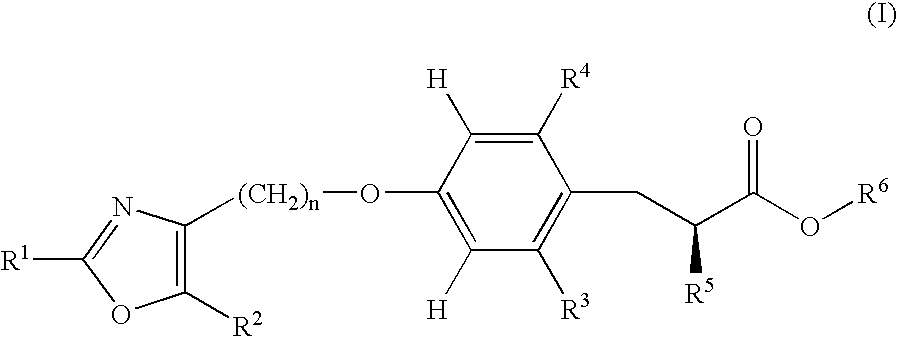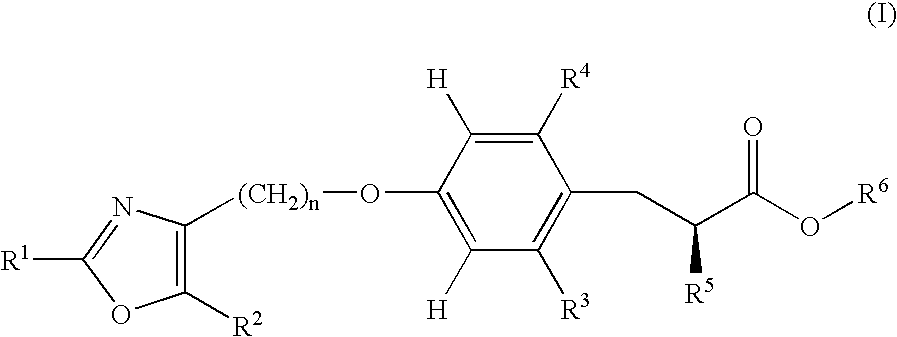Oxazole derivatives
a technology of oxazole and derivatives, applied in the field of new drugs, can solve the problems of lowering blood pressure and low ldl cholesterol, and achieve the effects of lowering triglycerides, lowering plasma glucose and insulin, and increasing hdl cholesterol
- Summary
- Abstract
- Description
- Claims
- Application Information
AI Technical Summary
Benefits of technology
Problems solved by technology
Method used
Image
Examples
example 1
a] (S)-4-Benzyl-3-[(2S,3R)-3-(4-benzyloxy-2-methyl-phenyl)-2-ethoxy-3-hydroxy-propionyl]-oxazolidin-2-one
[0195](S)-4-Benzyl-3-ethoxyacetyl-oxazolidin-2-one (12.45 g, 47 mmol) (for the preparation of (S)-4-benzyl-3-ethoxyacetyl-oxazolidin-2-one see: D. Haigh, H. C. Birrell, B. C. C. Cantello, D. S. Eggleston, R. C. Haltiwanger, R. M. Hindley, A. Ramaswamy, N. C. Stevens, Tetrahedron: Asymmetry 1999, 10, 1353-1367) was dissolved in dry dichloromethane (270 ml) under an argon atmosphere and the solution was cooled to −78° C. Triethylamine (7.98 ml, 57 mmol) was added, followed by the slow addition, over approximately 20 min, of di-n-butylboron triflate (1 M solution in dichloromethane, 50 ml, 50 mmol) such that the reaction temperature was kept below −70° C. The mixture was stirred at −78° C. for 50 min, the cooling bath was replaced with an ice bath and the mixture stirred at 0° C. for additional 50 min before being recooled to −78° C. A solution of 4-benzyloxy-2-methyl-benzaldehyde (...
example 1a
a] 3-(4-Benzyloxyx-2-methyl-phenyl)-2-ethoxy-3-hydroxy-propionic acid ethyl ester (mixture of stereoisomers)
[0209]To a −78° C. cold 2 M solution of lithium diisopropylamide (305 mmol) in THF / n-heptane (152.4 ml) was added a solution of ethoxy-acetic acid ethyl ester (45.2 ml, 331 mmol) in tetrahydrofuran (240 ml) within 1.5 h under an argon atmosphere. The mixture was stirred for 30 min. A solution of 4-benzyloxy-2-methyl-benzaldehyde (30 g, 132.6 mmol) in tetrahydrofuran (420 ml) was added dropwise over a period of 50 min. The reaction mixture was stirred 2 h at −78° C., poured onto ice water / aqueous ammonium chloride solution 1 / 1 and extracted two times with ethyl acetate. The combined extracts were washed three times with ice water / brine 1 / 1 and dried over sodium sulfate. The solvent was removed under reduced pressure and the residue purified by column chromatography (silica gel, n-heptane / AcOEt) to give 48.8 g (136.2 mmol) of the title compound as a mixture of stereoisomers as y...
example 2
a] 2-(4-Isopropoxy-phenyl)-4,5-dimethyl-oxazole 3-oxide; hydrochloride
[0221]Into a suspension of diacetyl monooxime (1 g, 9.9 mmol) and 4-isopropoxy-benzaldehyde (1.6 g, 9.9 mmol) in acetic acid (10 ml), dry hydrogen chloride was bubbled for 30 min under ice-cooling and for additional 45 min at ambient temperature. The reaction mixture was cooled to 0° C., diethyl ether (25 ml) was added within 5 min and the formed precipitate was filtered off and washed with ice-cold diethyl ether to yield the title compound (2.5 g, 8.8 mmol, 89%) as colorless crystals.
[0222]MS: 247.2 (M−HCl)+, 205.1, 188.1, 121.2, 93.2, 43.3.
b] 4-Chloromethyl-2-(4-isopropoxy-phenyl)-5-methyl-oxazole
[0223]To a solution of 2-(4-isopropoxy-phenyl)-4,5-dimethyl-oxazole 3-oxide; hydrochloride (2.5 g, 8.8 mmol) in chloroform (12 ml) was added a solution of phosphorous oxychloride (1 ml, 11 mmol) in chloroform (12 ml) within 5 min. The reaction mixture was heated under reflux for 45 min, cooled to 0° C. and made basic (p...
PUM
 Login to View More
Login to View More Abstract
Description
Claims
Application Information
 Login to View More
Login to View More - R&D
- Intellectual Property
- Life Sciences
- Materials
- Tech Scout
- Unparalleled Data Quality
- Higher Quality Content
- 60% Fewer Hallucinations
Browse by: Latest US Patents, China's latest patents, Technical Efficacy Thesaurus, Application Domain, Technology Topic, Popular Technical Reports.
© 2025 PatSnap. All rights reserved.Legal|Privacy policy|Modern Slavery Act Transparency Statement|Sitemap|About US| Contact US: help@patsnap.com



